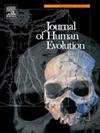坦桑尼亚Laetoli上Laetolil层的新古人类化石
IF 3.1
1区 地球科学
Q1 ANTHROPOLOGY
引用次数: 0
摘要
在坦桑尼亚北部Laetoli的上Laetolil床上新发现的古人类化石包括相关的左右下颌碎片和三颗分离的牙齿。对这些标本进行了描述,并与以前从Laetoli收集的标本以及从非洲东部其他地区收集的阿法南猿标本进行了比较。这些标本有助于更好地了解拉托里古人类的形态和形态差异,并为批判性地重新评估阿法古猿的分类地位提供依据。Laetoli的古人类在形态和度量上与哈达尔的古人类非常相似,特别是考虑到它们在时间和地理上的分离,它们有理由被包括在一个单一的物种中,即阿法种古人类。与他们更大的年龄相一致,莱托利古人类保留了一些特征,这些特征可能被推断为比哈达尔古人类更原始,但没有足够的理由认为他们是在一个进化谱系中的时间同态动物。关于阿法南方古猿和阿法南方古猿究竟是同种还是同源进化谱系的成员这一长期争论仍未得到解决,但目前的证据与一个进化物种形成事件和这两个分类群作为独立物种的认识最为一致。本文章由计算机程序翻译,如有差异,请以英文原文为准。
New fossil hominins from the Upper Laetolil Beds, Laetoli, Tanzania
New finds of fossil hominins from the Upper Laetolil Beds at Laetoli in northern Tanzania include associated right and left mandibular fragments and three isolated teeth. The specimens are described and compared with those previously collected from Laetoli, as well as with Australopithecus afarensis specimens from other localities in eastern Africa. The additional specimens contribute to a better understanding of the morphological and metrical variation among the hominins from Laetoli and provide the basis for critically reassessing the taxonomic status of A. afarensis. The Laetoli hominins are remarkably similar morphologically and metrically to those from Hadar, especially when considering their temporal and geographic separation, and together, they are justifiably included in a single species, A. afarensis. Consistent with their greater age, the Laetoli hominins retain several features that might be inferred to be more primitive than those from Hadar hominins, but there is insufficient justification to consider them chronomorphs within an anagenetically evolving lineage. The long-standing debate about whether Australopithecus anamensis and A. afarensis are conspecifics or time-successive members of a single anagenetically evolving lineage remains unresolved, but the current evidence is most consistent with a cladogenetic speciation event and the recognition of these two taxa as separate species.
求助全文
通过发布文献求助,成功后即可免费获取论文全文。
去求助
来源期刊

Journal of Human Evolution
生物-进化生物学
CiteScore
6.30
自引率
15.60%
发文量
104
审稿时长
3 months
期刊介绍:
The Journal of Human Evolution concentrates on publishing the highest quality papers covering all aspects of human evolution. The central focus is aimed jointly at paleoanthropological work, covering human and primate fossils, and at comparative studies of living species, including both morphological and molecular evidence. These include descriptions of new discoveries, interpretative analyses of new and previously described material, and assessments of the phylogeny and paleobiology of primate species. Submissions should address issues and questions of broad interest in paleoanthropology.
 求助内容:
求助内容: 应助结果提醒方式:
应助结果提醒方式:


